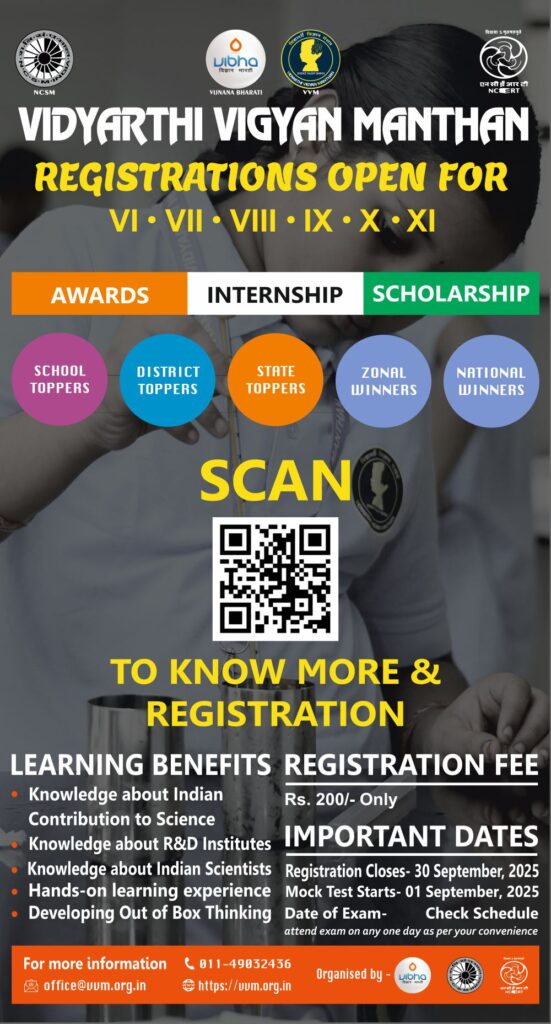Examinations are essential to a student’s life, as they have the power to impact their future significantly. There are many exams across various specialisations, both unofficial and official, that institutions conduct to assess their students’ academic prowess and other aspects. And one of those exams is Vidyarthi Vigyan Manthan, a test to identify individuals with exceptional talents in science, for students in classes 6th to 11th. But what is it about? This article will detail it:
Vidyarthi Vigyan Manthan (VVM)
Vidyarthi Vigyan Manthan (VVM) is an initiative of Vijnana Bharati (VIBHA), which is being organized in collaboration with NCSM and NCERT.
It is a digital based largest Science Talent Search Examination for school students of standard VI to XI to create awareness, to generate affinity towards pure science & foster the excellence, and mentoring. It is a national program conceptualised to identify bright minds with a scientific aptitude from the student community and nurture them.
Interested participants may visit vvm.org.in for more information and to register in this competition.
A. Origin:
Launched in 2016, It is the result of joint efforts from organisations like the NCERT (National Council of Educational Research and Training) and NCSM (National Council of Science Museums); the former being a body responsible for improving the educational standards in India while the latter is institution under Ministry of culture that promotes the values of science through museums. It also has the support of the Vijnana Bharati (VIBHA), a national movement that aims to spread the importance of science and innovative methods.
B. What is it?
In exact terms, it is an aptitude test in science for students from class VI to XI. The words ‘Vidartgi Vigyan Manthan’ mean “Student Science Churning” in Hindi and Sanskrit. A few of its objectives are:
- To create interest in science among students
- To show the importance of science
- To open career paths in science for students
- To integrate the Indian science heritage into modern education
- To enhance critical and analytical thinking
C. Purpose:
The purpose of conducting this exam is to improve the understanding of science among the younger generations. It also helps to:
- Promote scientific temper:
It aims to improve scientific temper and understanding and instil curiosity about science and its various applications across different fields.
- Identify scientific talents:
The exam also aims to find child prodigies and provide them with better educational opportunities, like scholarships.
- Practical application:
It allows students to understand the branches of textbook science and applied science. Since many schools only focus on teaching what’s in the textbook, it won’t help students to grasp a few concepts and such practicality, to show reactions rather than memorising it in words, it will help students understand concepts better.
- Foster innovation:
This also gives a chance for people to find innovative and creative methods to inculcate science and increase its prominence.
D. Important particulars:
Here is some other information about Vidyarthi Vigyan Manthan:
a. Syllabus:
The preparation for this exam includes a syllabus that consists:
- NCERT Science textbooks for your class (6th to 11th):
This covers 40% of the syllabus for the exam and covers physics, chemistry, biology, environmental science, and some basic science concepts.
- Indian Contributions to Science:
This topic covers 20% of the syllabus, and here, one has to focus on ancient and modern Indian scientists and their contribution to their particular fields and the entirety to the development of science. Examples are Aryabhata and Brahmagupta (Mathematics), Varahamihira and Bhaskaracharya (Astronomy), Charaka and Sushruta (Medicine), and other contributors like C.V. Raman, A.P.J. Abdul Kalam, Homi Bhabha, and many others.
- Biographies of Prominent Indian Scientists:
This portion covers 20% of the syllabus, and one has to study about the great scientists and their biographies, and a few examples are Dr. Vikram Sarabhai, Jagadish Chandra Bose, Dr. Shanti Swarup Bhatnagar, and others.
- General knowledge, Logic, and Reasoning:
Covering 20% of the portion, this part focuses on aspects like analytical and scientific thinking, problem-solving, puzzles, pattern observation, current affairs in the scientific world, sequences, and reason-based problems.
b. How is it held?
It is a digital-based exam conducted through a secure platform. It happens in a duration of 90 minutes and has a multiple-choice question format (MCQs). And it is available in multiple languages other than English, which are Hindi, Marathi, Tamil, Telugu, Kannada, Assamese, Sanskrit, Urdu, Gujarati, and Bengali, as per the convenience of the student. And for 2025, the exact dates and other information have not been announced yet, but in 2024, it has two slots: one on 23rd October or 27th October.
c. Resources:
Here is a list of resources students can use to prepare for this exam:
- NCERT Science Textbooks
- VVM Study Material, which is available on vvm.org.in
- VVM app, which provides content and mock tests
- Newspapers
- Science magazines and journals
- Biographies of prominent scientists
E. Regulations:
Though it is an online exam, the supervision of such an important exam is seriously monitored. Here are some rules for the students to keep in mind while participating in this exam:
- It is open to students from class 6th to class 11th (Intermediate first year)
- Students must register through either their school or as an individual on the official website.
- The online exam is either conducted through a mobile application (available on both Android and IOS) or a web browser, and hence, a stable internet connection is required.
- The selection of your language must be done while registering
- The exam is held in a given time slot (between 10:00 AM to 6:00 PM), and a student can log in at any time within that timeframe, but they only have one login attempt.
- After registration, each individual will receive a unique ID and password in their email or SMS.
- Devices that are allowed are smartphones, tablets, laptops, or desktops with a camera, which needs to be active while attempting the exam.
- The exam is carefully observed with an AI program, and it may record webcam footage, screen activity, and monitor any suspicious noises or activities to prevent malpractice. If caught, it results in the disqualification of the student permanently from attempting the exam.
- A student should also not use their material, written notes, or browsing online for answers, as it is a closed-end examination
- No impersonation or multiple attempts at the exam are allowed.
F. Exam Pattern:
- The exam will have a total of 100 questions to be solved and answered in 90 minutes (one and a half hours).
- Each question will carry 1 mark, and there are no negative marks
- It is in a multiple-choice question format
- It will be attempted in a time window, 10:00 AM to 6:00 PM, on a selected date announced by the website.
- The exam questions are split between the topics: Science NCERT textbook of your grade (40 questions), Indian scientists’ contributions (20 questions), Biographies of notable scientists (20 questions), and Logic and reasoning questions, along with general science knowledge (20 questions)
G. Benefits:
There are many benefits for a student’s academic career after scoring good marks in this exam, and they are:
- School Level Winners: The students of this level will be awarded certificates of merit, and the top ones are selected for the District level camp, the next level
- District Level Winners: here, the top 3 students per class per district will receive district winner certificates, and selected for the State level camp
- State Level Winners: The top 3 students per class per state will receive a State winner trophy and certificate, cash prizes, and eligibility for the national camp. They can also participate in workshops and even visit science labs.
- National Level Winners: the first prize is a cash prize of 25,000/-, a National Winner Trophy, and a certificate. The second prize is a cash prize of 15,000/-, a Trophy, and a certificate. The third prize winner receives a 10,000/- cash prize, a Trophy, and a certificate. The winners also get opportunities to visit scientific and research institutions like ISRO (Indian Space Research Organisation), NASA (National Aeronautics and Space Administration), and DRDO (Defence Research and Development Organisation).
- Other benefits include digital certificates to all participants and access to study material and other helpful resources.
- Even the mentors of the students get recognised, awarded, and appreciated for their efforts.
H. Career options:
Though the exam itself doesn’t give jobs, it does open doors for many paths for a student. Here are some career options to think of after writing Vidyarthi Vigyan Manthan:
- Scientist or Researcher: Students can choose to be a scientist or researcher in a field of their interest, like physics, mathematics, chemistry, biology, and environmental science.
- Doctor or Biomedical student: Students can also pursue a career in the medical field and can either be a General physician, nurse, chemist, or specialised doctor.
- Ecologist: Students can study ecology to work in wildlife care centres, sanctuaries, or also deal with climate science.
- Astronomer: Students can also study astronomy and join institutes like ISRO and NASA, dealing with subjects like astrophysics and planetary science, and also participate in space programs and projects like space shuttles and satellites.
- Data scientist: This allows students to combine mathematics, coding, and logical reasoning to create developments in other fields like genetics, biotechnology, and artificial intelligence.
To conclude, Vidyarthi Vigyan Manthan isn’t just an exam but a gateway for young students to understand the scope of science and contemplate their careers. They can rise in their respective field of interest, and this exam provides many opportunities that are beneficial to their academics and careers. It aims to nurture curiosity and interest in the scientific field and research that can allow more shining and creative individuals to have a chance to bloom in their interests.
For more in-depth information and the latest updates, you can visit their official website.
Also read: SpaceX Revolutionises Space Travel with Mid-Air Rocket Catch











